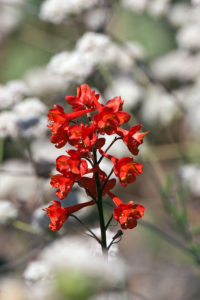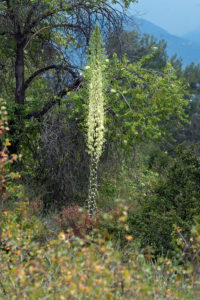This year most of the BFS wilflowers were finished blooming by May, but a couple our more spectacular flowers bloomed in June, after most of the students were gone for the summer.
Chaparral Yucca (Hesperoyucca whipplei), also known as Our Lord’s Candle and Spanish Bayonet, grows in foothills and valleys of California and northern Baja California. Local native peoples used fiber from the leaves of Chaparral Yuccas for sandals, cloth, and rope. Fruits, seeds, stalk, and flower were also used for food.
Chaparral Yuccas, which are pollinated exclusively by the California Yucca Moth (Tegeticula maculata), take more than five years to mature and produce the spectacular flowering stalk, after which they die; although sometimes the dead plants replaced by offsets around the base. We have only a few Chaparral Yuccas at the BFS, so it is a special treat to see on in bloom.

Flowers of Scarlet Larkspur (Delphinium cardinale) blooming among buckwheat in the Neck. ©Nancy Hamlett.
Like the Chaparral Yucca, Scarlet Larkspur is native only to California and Baja California. In good years, the flowering stalks may grow over six feet tall. The bright read trumpet-shaped flowers are pollinated by hummingbirds and native bees.
We have several nice patches of Scarlet Larkspur at the BFS, but the bloom varies a lot from year to year, depending on the weather. Although most the BFS Scarlet Larkspur did not do much this year, a patch in the Neck put on a nice show.
